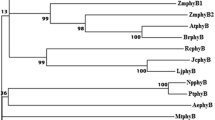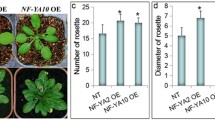Abstract
Arabidopsis thaliana blue-light inhibitor of cryptochromes 1 (AtBIC1) suppresses the dimerization of cryptochromes, which is necessary for cryptochrome function in plants. Additionally, AtBIC1 interacts with brassinazole-resistant 1 (BZR1) and phytochrome-interacting factor 4 (PIF4) transcription factors for integrating brassinosteroid (BR) and light signaling to promote plant growth. Thus, AtBIC1 overexpression is postulated to facilitate a desirable plant architecture for a high yield of crops. We first confirmed the phenotypes of transgenic Arabidopsis plants overexpressing AtBIC1, showing increases in leaf growth, plant height, and seed productivity. Next, we applied the AtBIC1 overexpression approach to soybean as a target crop. The transgenic soybean plants overexpressing AtBIC1 exhibited a significantly tall phenotype (i.e., an increased plant height) but with reduced root growth. In particular, the transgenic soybean plants displayed altered plant architecture, such as greatly elongated hypocotyls, during growth under both greenhouse and field conditions. Due to the phenotype of increased plant height, the total seed weights from the transgenic soybean plants decreased. These results suggest that the greater growth of above-ground parts might result in diminished growth of underground parts (i.e., roots), reducing the seed productivity of soybean. Collectively, these results suggest that AtBIC1 overexpression functions similarly in elongated growth to increase plant heights in both Arabidopsis and soybean, whereas it functions differently in root growth between the two plants.







Similar content being viewed by others
References
Alcivar A, Jacobson J, Rainho J, Meksem K, Lightfoot DA, Kassem MA (2007) Genetic analysis of soybean plant height, hypocotyl and internode lengths. J Agric Food Environ Sci 1(1):1–20
Chen L, Cai Y, Liu X, Yao W, Guo C, Sun S, Wu C, Jiang B, Han T, Hou W (2018) Improvement of soybean Agrobacterium-mediated transformation efficiency by adding glutamine and asparagine into the culture media. Int J Mol Sci 19:3039
Choi H, Oh E (2016) PIF4 integrates multiple environmental and hormonal signals for plant growth regulation in Arabidopsis. Mol Cells 39:587–593
Divi UK, Krishna P (2009) Brassinosteroid: a biotechnological target for enhancing crop yield and stress tolerance. Nat Biotechnol 26:131–136
Grbic B, Bleecker AB (1996) An altered body plan is conferred on Arabidopsis plants carrying dominant alleles of two genes. Development 122:2395–2403
Hada A, Krishnan V, Jaabir MSM, Kumari A, Jolly M, Praveen S, Sachdev A (2018) Improved Agrobacterium tumefaciens-mediated transformation of soybean [Glycine max (L.) Merr.] following optimization of culture conditions and mechanical techniques. In Vitro Cell Dev Biol Plant 54:672–688
Hinchee MAW, Connor-Ward DV, Newell CA, McDonnell RE, Sato SJ, Gasser CS, Fischhoff DA, Re DB, Fraley RT, Horsch RB (1988) Production of transgenic soybean plants using Agrobacterium-mediated DNA transfer. Nat Biotechnol 6:915–922
Hu R, Fan C, Li H, Zheng Q, Fu YF (2009) Evaluation of putative reference genes for gene expression normalization in soybean by quantitative real-time RT-PCR. BMC Mol Biol 10:93
Kim HJ, Kim MJ, Pak JH, Jung HW, Choi HK, Lee YH, Baek IY, Ko JM, Jeong SC, Pack IS, Ryu KH, Chung YS (2013) Characterization of SMV resistance of soybean produced by genetic transformation of SMV-CP gene in RNAi. Plant Biotechnol Rep 7:425–433
Kim HJ, Kim MJ, Pak JH, Im HH, Lee DH, Kim KH, Lee JH, Kim DH, Choi HK, Jung HW, Chung YS (2016) RNAi-mediated soybean mosaic virus (SMV) resistance of a Korean soybean cultivar. Plant Biotechnol Rep 10:257–267
Kim MJ, Kim HJ, Pak JH, Cho HS, Choi HK, Jung HW, Lee DH, Chung YS (2017) Overexpression of AtSZF2 from Arabidopsis showed enhanced tolerance to salt stress in soybean. Plant Breed Biotech 5(1):1–15
Kim MJ, Kim JK, Kim HJ, Pak JH, Lee JH, Kim DH, Choi HK, Jung HW, Lee JD, Chung YS, Ha SH (2012) Genetic modification of the soybean to enhance the β-carotene content through seed-specific expression. PLoS ONE 7(10):e48287
Li S, Cong Y, Liu Y, Wang T, Shuai Q, Chen N, Gai J, Li Y (2017) Optimization of Agrobacterium-mediated transformation in soybean. Front Plant Sci 8:246
Ma L, Wang X, Guan Z, Wang L, Wang Y, Zheng L, Gong Z, Shen C, Wang J, Zhang D, Liu Z, Yin P (2020) Structural insights into BIC-mediated inactivation of Arabidopsis cryptochrome 2. Nat Struct Mol Biol 27:472–479
Oh E, Zhu JY, Bai MY, Arenhart RA, Sun Y, Wang ZY (2014) Cell elongation is regulated through a central circuit of interacting transcription factors in the Arabidopsis hypocotyl. Elife 3:e03031
Olhoft PM, Flagel LE, Donovan CM, Somers DA (2003) Efficient soybean transformation using hygromycin B selection in the cotyledonary-node method. Planta 216:723–735
Paz MM, Martinez JC, Kalvig AB, Fonger TM, Wang K (2006) Improved cotyledonary node method using an alternative explant derived from mature seed for efficient Agrobacterium-mediated soybean transformation. Plant Cell Rep 25:206–213
Teichmann T, Muhr M (2015) Shaping plant architecture. Front Plant Sci 6:233
Verma K, Saini R, Rani A (2014) Recent advances in the regeneration and genetic transformation of soybean. J Innov Biol 1(1):15–26
Wang Q, Zuo Z, Wang X, Gu L, Yoshizumi T, Yang Z, Yang L, Liu Q, Liu W, Han YJ, Kim JI, Liu B, Wohlschlegel JA, Matsui M, Oka Y, Lin C (2016) Photoactivation and inactivation of Arabidopsis cryptochrome 2. Science 354:343–347
Wang X, Wang Q, Han YJ, Liu Q, Gu L, Yang Z, Su J, Liu B, Zuo Z, He W, Wang J, Liu B, Matsui M, Kim JI, Oka Y, Lin C (2017) A CRY-BIC negative-feedback circuitry regulating blue light sensitivity of Arabidopsis. Plant J 92:426–436
Wang Q, Liu Q, Wang X, Zuo Z, Oka Y, Lin C (2018a) New insights into the mechanisms of phytochrome-cryptochrome coaction. New Phytol 217:547–551
Wang Q, Zuo Z, Wang X, Liu Q, Gu L, Oka Y, Lin C (2018b) Beyond the photocycle-how cryptochromes regulate photoresponses in plants? Curr Opin Plant Biol 45:120–126
Yang Z, Yan B, Dong H, He G, Zhou Y, Sun J (2021) BIC1 acts as a transcriptional coactivator to promote brassinosteroid signaling and plant growth. EMBO J 40:e104615
Yeom WW, Kim HJ, Lee KR, Cho HS, Kim JY, Jung HW, Oh SW, Jun SE, Kim HU, Chung YS (2020) Increased production of α-linolenic acid in soybean seeds by overexpression of lesquerella FAD3-1. Front Plant Sci 10:1812
Acknowledgements
This work was supported by the National Research Foundation of Korea (NRF) grant funded by the Korean government (MSIT) (NRF-2020R1A2C2010057 granted to Y.S. Chung) and Green Fusion Technology Program funded by Ministry of Environment, and in part by the Mid-career Researcher Program (NRF-2021R1A2C1012562 granted to J.I. Kim) through the National Research Foundation of Korea (NRF) funded by the Korean government (MSIT) in the Republic of Korea.
Author information
Authors and Affiliations
Corresponding authors
Additional information
Publisher's Note
Springer Nature remains neutral with regard to jurisdictional claims in published maps and institutional affiliations.
Supplementary Information
Below is the link to the electronic supplementary material.

11816_2021_693_MOESM1_ESM.jpg
Supplementary file1 Supplementary Fig. 1. Seed productivity of transgenic Arabidopsis overexpressing Arabidopsis thaliana blue-light inhibitor of cryptochromes 1 (AtBIC1) gene. a Representative siliques of wild-type (Col-0) and transgenic plant overexpressing AtBIC1 (35S:AtBIC1). Scale bar, 5 mm. b Measurement of average silique weights. Data represent means ± SD (n ≥ 30). Statistically significantly difference compared with Col-0 is indicated by asterisk (*) when P < 0.05. c Images of harvested seeds. Scale bar = 1 mm. (JPG 115 kb)

11816_2021_693_MOESM2_ESM.jpg
Supplementary file2 Supplementary Fig. 2. T1 seeds harvested from transgenic soybean plants with AtBIC1. From transgenic plants (T0) grown in the greenhouse, T1 seeds of transgenic lines (#1 to #20) were harvested. (JPG 187 kb)

11816_2021_693_MOESM3_ESM.jpg
Supplementary file3 Supplementary Fig. 3. Measurements of plant height, fresh weight, and root weight using individual plants of T2 transgenic lines with AtBIC1. Seeds of NT and transgenic plants were grown in the growth chamber, and plant height, fresh weight, and root weight were measured after 3 weeks. The individual plants used in this study originated from T2 transgenic lines #7 (a), #9 (b), #10 (c), and #15 (d). NT, non-transgenic soybean plant. 7, 6, 3, and 19 plants from T2 transgenic lines #7, #9, #10, and 15 were used for the analysis. (JPG 204 kb)

11816_2021_693_MOESM4_ESM.jpg
Supplementary file4 Supplementary Fig. 4. Measurements of hypocotyl lengths from soybean plants grown in the GMO field. Hypocotyl lengths were measured from the soybean plants in flowering season (planted in June 23rd and measured in August 16). NT, non-transgenic soybean plant; #10-2, #10-3, #15-1, and #15-2, transgenic lines (T2) with AtBIC1. Data represent means ± SD (n ≥ 10), and statistically difference compared with NT is indicated by asterisk (**) when P < 0.01. (JPG 33 kb)

11816_2021_693_MOESM5_ESM.jpg
Supplementary file5 Supplementary Fig. 5. Root phenotypes of Arabidopsis plants. The photographs of roots were taken with 6-week-old plants grown on soil under long-day conditions (22°C with a 16-h photoperiod). Scale bar = 5 cm. (JPG 87 kb)
Rights and permissions
About this article
Cite this article
Cho, H.S., Lee, Y.J., Kim, H.J. et al. Overexpression of Arabidopsis thaliana blue-light inhibitor of cryptochromes 1 gene alters plant architecture in soybean. Plant Biotechnol Rep 15, 459–469 (2021). https://doi.org/10.1007/s11816-021-00693-2
Received:
Revised:
Accepted:
Published:
Issue Date:
DOI: https://doi.org/10.1007/s11816-021-00693-2




